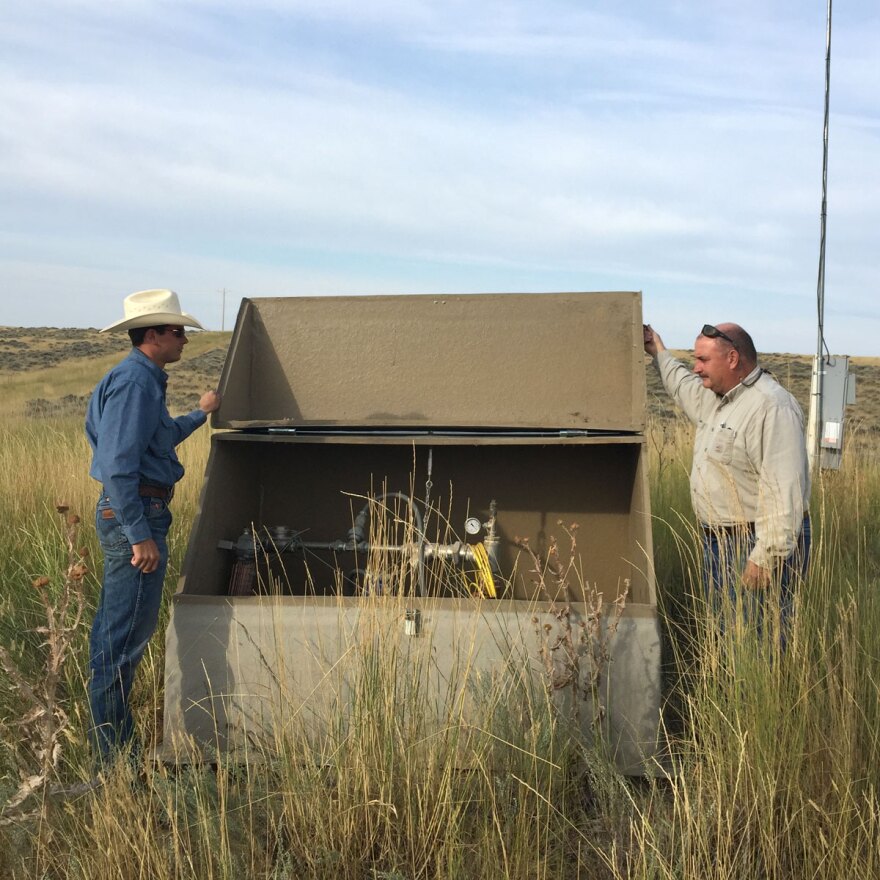Driving around the Powder River Basin in northeast Wyoming with Jeff Gillum and Jeff Campbell is like playing Where's Waldo?
Where most people would see a yard full of heavy machinery or an unassuming patch of prairie, Campbell and Gillum are constantly spotting coalbed methane wells. They point out the signature tan well houses everywhere: in front yards, in a parking lot, even at the driving range at the golf course.
Wyoming has almost 4,000 orphaned coal methane wells, abandoned by the companies that owned them when they went bankrupt. Now Gillum and Campbell, who work for the Wyoming Oil and Gas Conservation Commission, are in charge of making sure they get cleaned up and plugged.
In Wyoming, the bust of the industry has left the state on the hook for tens of millions of dollars in cleanup. While most states and the federal government make companies put up at least some money in advance to pay for any mess they leave behind, it's often not enough.
"It takes a lot more work than a lot of people realize," said Campbell.

Compared to conventional oil and gas wells, coalbed methane wells are relatively easy and inexpensive to plug. Even so, the process is lengthy. First, the gas-producing formations have to be sealed off, using a kind of super-absorbent clay called bentonite, or if there's a lot of water in the formation, a mechanical device called a bridge plug.
Then, a different crew comes in to place cement plugs at various depths, to make sure the gas doesn't leak up the well bore. Then, another crew comes in to 'cut and cap'— cut off the pipe below the surface and cap the connection to any pipelines. In all, Gillum and Campbell have three contractors and roughly 20 people working on the various stages of the process on any given day. Together, they will plug maybe five or six wells a day.
Newer unconventional oil and gas wells are even harder to plug, mostly because of their depth. A deeper well requires more cement and more specialized equipment.
"The costs to properly plug and reclaim these new, deep oil wells are going to be much, much more expensive," said Jill Morrison, an organizer with the Powder River Basin Resource Council.

While the cost of plugging a coalbed methane wells is typically under $10,000, deep oil wells can run into the tens or hundreds of thousands. Given the falling price of oil and shaky financials in the industry, Morrison doesn't think that's getting enough attention, in Wyoming or elsewhere in the country.
"I'm hoping Wyoming, because we do have so much experience, that we can lead on this issue," she said.
Mark Watson, Wyoming's oil and gas supervisor, recently proposed new rules aimed at protecting the state from future cleanup costs, but it's an open question whether they'll be enough. Right now, companies can get a 'blanket bond' that covers all their wells on private lands for $75,000. The new rules double that, to $150,000.
"As far as where we came up with the number, there's really not a lot of science to it," Watson said. "For some companies, it would be more than enough, and for some companies it wouldn't be enough to plug all their wells."
The new rules also give regulators more oversight when wells are sold from one company to another. During the coalbed methane boom, large companies sold their wells — and the responsibility for plugging them — to smaller companies that then went under when prices crashed.
As proposed, the new rules would allow the Oil and Gas Commission to hold on to the seller's bond for up to six months, to make sure the buyer is financially sound. But analyzing a company's financials isn't an easy task. In the recent oil price crash, even some relatively big companies have gone bankrupt, and analysts see the potential for more carnage on the horizon.
"One of the things that we probably need to do a better job at is identifying companies that aren't solvent," Watson said, adding, "and identifying them sooner than we did when the coalbed play ended."
Inside Energy is a public media collaboration, based in Colorado, Wyoming and North Dakota, focusing on the energy industry and its impacts.







